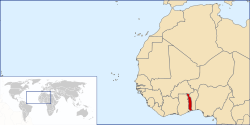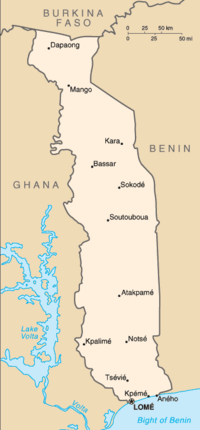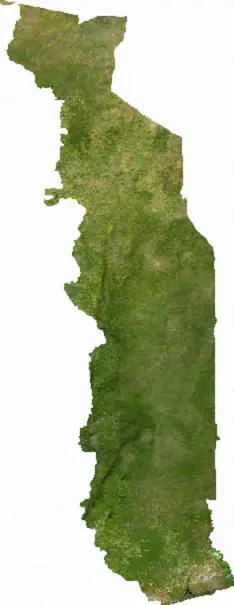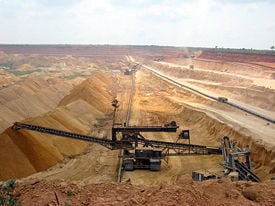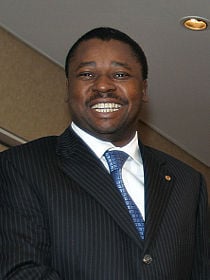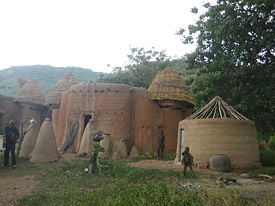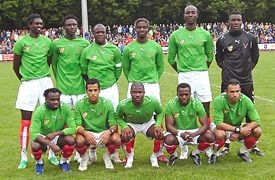Togo
| République togolaise Togolese Republic |
||||||
|---|---|---|---|---|---|---|
|
||||||
| Motto: "Travail, Liberté, Patrie"  (French) "Work, Liberty, Homeland" |
||||||
| Anthem:¬†Salut √† toi, pays de nos a√Įeux¬†¬†(French) "Hail to thee, land of our forefathers" |
||||||
| Capital (and largest city) | Lom√© 6¬į7‚Ä≤N 1¬į13‚Ä≤E | |||||
| Official languages | French | |||||
| Vernacular languages | Gbe languages such as Ewe, Mina and Aja; Kabiyé; and others. | |||||
| Demonym | Togolese | |||||
| Government | Republic | |||||
|  -  | President | Faure Gnassingbé | ||||
|  -  | Prime Minister | Gilbert Fossoun Houngbo[1] | ||||
| Independence | ||||||
|  -  | from France | April 27, 1960  | ||||
| Area | ||||||
|  -  | Total | 56,785 km² (125th) 21,925 sq mi  |
||||
|  -  | Water (%) | 4.2 | ||||
| Population | ||||||
|  -  | 2009 estimate | 6,619,000[2] (101st1) | ||||
|  -  | Density | 116.6/km² (93rd²) 301.9/sq mi |
||||
| GDP (PPP) | 2009 estimate | |||||
|  -  | Total | $5.612 billion[3]  | ||||
|  -  | Per capita | $826[3]  | ||||
| GDP (nominal) | 2009 estimate | |||||
|  -  | Total | $2.865 billion[3]  | ||||
|  -  | Per capita | $422[3]  | ||||
| Currency | CFA franc (XOF) |
|||||
| Time zone | GMT (UTC+0) | |||||
| Internet TLD | .tg | |||||
| Calling code | [[++228]] | |||||
| 1 Estimates for this country explicitly take into account the effects of excess mortality due to AIDS; this can result in lower life expectancy, higher infant mortality and death rates, lower population and growth rates, and changes in the distribution of population by age and sex than would otherwise be expected. Rankings based on 2005 figures CIA World Factbook - Togo ² Rankings based on 2005 figures (source unknown) |
||||||
Togo, officially the Togolese Republic, is a thin sliver of land in Western Africa. From its 32-mile (51 km) coastline on the Gulf of Guinea, it stretches north approximately 320 miles to Burkina Faso. It is bounded on the west by Ghana and on the east by Benin. The capital city, Lomé, is also the largest city and port.
Togo was once part of the area known as the "Slave Coast" in the seventeenth century. It passed from German control at the start of World War I and was split between France and Britain. Seven years after independence, Lt. Col. Gnassingbe Eyadema seized power and held it for 38 years, making him Africa's longest sitting dictator until he died in 2005. His regime was marked by torture, assassinations, and abuses of civil liberties and human rights. His death resulted in a political crisis. His son has inherited his position but, under international pressure, has taken tentative steps to include the opposition in the government. Nevertheless, the army still dominates the country.
Geography
Togo is a small, thin sub-Saharan nation. It borders the Bight of Benin in the south; Ghana lies to the west; Benin to the east; and to the north Togo is bound by Burkina Faso. In the south, it has a short Gulf of Guinea coast, on which the capital Lomé is located. It stretches inland for 360 miles but is only 31 miles wide at the coast and 100 miles at its widest point.
In the north, the land is characterized by a gently rolling savanna. The center of the country is hilly. The southern plateau reaches a coastal plain with extensive lagoons and marshes. The land area is 21,925 square miles (56,785 km²), with an average population density of 253 people per square mile (98 people per square kilometer).
The climate is warm and humid on the coast, but drier and slightly cooler in the north. The climate is tropical and humid for seven months, while the dry, desert winds of the Harmattan blow south from November to March, bringing cooler weather though little moisture. Annual temperatures vary between 75 and 98 degrees Fahrenheit (23 and 35 degrees Celsius) in the south and 65 to 100 degrees Fahrenheit (18 to 38 degrees Celsius) in the north.
Lake Togo, part of a lagoon separated from the Atlantic Ocean by a narrow coastal strip, is shallow and popular for water sports. Togo is an Ewe (pronounced Ev'hé) word meaning "lake" or "lagoon."
Togo is named after the town of Togoville, where Gustav Nachtigal signed a treaty with Mlapa III in 1884, establishing a German protectorate.
Togo consists of six geographical regions. The coastal region is low-lying, sandy beach backed by the Tokoin plateau, a marsh, and the Lake Togo lagoon. The Tokoin (Ouatchi) plateau extends about 20 miles (32 kilometers) inland at an elevation of 200 to 300 feet (61 to 91 meters). To the northeast, a higher tableland is drained by the Mono, Haho, Sio rivers and their tributaries. The Atakora massif stretches diagonally across Togo from the town of Kpalime northeast; at different points it is known as the Danyi and Akposso plateau, Fetish massif, Fazao mountain, Tchaoudjo massif, and Kabye mountains. The highest point is the Pic d'Agou at 3,937 feet (986 meters). North of the mountain range is the Oti plateau, a savanna land drained by the river of the same name. A higher, semi-arid region extends to the northern border.
Flora and fauna
Ibis, herons, pelicans, parrots and other bird species are found around Lake Togo. Monkeys, lions, elephants, antelopes, gazelles, buffaloes, and warthogs are in Keran National Park.
History
Pre-colonial era
The population of the central mountains is perhaps the oldest in Togo, with recent archaeological research dating the presence of the Tchamba, Bogou, and Bassar people as far back as the ninth century. Northern Mossi kingdoms date back to the thirteenth century. During the period from the eleventh century to the sixteenth century, various tribes entered the region from all directions: the Ewé from Nigeria and Benin and the Mina and Guin from Ghana. Most settled in coastal areas. Other research suggests the Kabye and others were the last to settle in the Kara region, coming from Kete-Krachi in Ghana as recently as 250 years ago. Parts of north Togo were for a long time under the influence of Islamic kingdoms, such as that of Umar Tal of the nineteenth century.
European presence
European presence began in the fifteenth century and became permanent from the sixteenth. Though the Danish, Dutch, Spanish, British, German, and French all sailed the coastal region, the Portuguese were the first to establish local economic control. For the next three centuries the area that is Togo today was sandwiched between the two powerful slave trading kingdoms of Ashanti and Dahomey. Consequently the Togolese population was overrepresented among those sold into the trans-Atlantic slave trade. The coastal region was a major raiding center for Europeans in search of slaves, earning Togo and the surrounding region the name "The Slave Coast." During the same period a growing Arab-controlled trans-Saharan trade in slaves, kola, and gold passed through Togo.
In an 1884 treaty signed at Togoville, Germany declared a protectorate over a stretch of territory along the coast and gradually extended its control inland. This became the German colony Togoland in 1905. After World War I, the colony became two League of Nations mandates, administered by the United Kingdom and France. After World War II, these mandates became UN Trust Territories. The residents of British Togoland voted to join the Gold Coast as part of the new independent nation of Ghana, and French Togoland became an autonomous republic within the French Union.
Independence
Independence came in 1960 under Sylvanus Olympio. Olympio was murdered by Lt. Col. Gnassingbe Eyadema, who usurped power on January 13, 1967.
Eyadema died in early 2005 after 38 years in power, as Africa's longest sitting dictator. The military's immediate but short-lived installation of his son, Faure Gnassingbe, as president provoked widespread international condemnation. Gnassingbe stood down and called elections that he won two months later. The opposition claimed that the election was fraudulent. The developments of 2005 led to renewed questions about a commitment to democracy made by Togo in 2004 in a bid to normalize ties with the European Union, which had cut off aid in 1993 over the country's human rights record. Moreover, up to 400 people were killed in the political violence surrounding the presidential poll, according to the UN. Around forty thousand Togolese fled to neighboring countries.
Economy
Togo's small sub-Saharan economy is heavily dependent on both commercial and subsistence agriculture, which provides employment for 75 percent of the labor force. Cocoa, coffee, and cotton together generate about 40 percent of export earnings. Togo is self-sufficient in basic food goods when harvests are normal, with occasional regional supply difficulties.
In the industrial sector, phosphate mining is by far the most important activity, although it has suffered from the collapse of world phosphate prices and increased foreign competition. Togo is the world's fifth largest exporter of calcium phosphate.
Togo's GNI per capita is US $380 (World Bank, 2005). As per capita income shrank with the cutoff of donor aid, an informal‚ÄĒand illegal‚ÄĒeconomy emerged, including money laundering, human trafficking, trade in illegal weapons and drugs, and smuggling. Togo is considered a major drug trafficking hub.
Togo serves as a regional commercial and trade center. The deep waters off Lome have made it a major regional port. However, the government's decade-long effort, supported by the World Bank and the International Monetary Fund, to implement economic reform measures, encourage foreign investment, and bring revenues in line with expenditures has stalled. Political unrest jeopardized the reform program, shrank the tax base, and disrupted vital economic activity. Progress depends on increased openness in government financial operations (to accommodate increased social service outlays) and possible downsizing of the military, on which the regime has depended to stay in power. Lack of aid, along with depressed cocoa prices, has caused the GDP to drop.
Togo imports most of its products from Ghana, which accounted for 26 percent of Togo's total purchases in 2000. Togo exports mostly to Benin, Nigeria, Ghana, and Colombia.
Politics
Togo's transition to democracy is stalled. Its democratic institutions remain nascent and fragile. President Gnassingbé Eyadéma, who ruled Togo under a one-party system for nearly 25 of his 37 years in power, died of a heart attack on February 5, 2005. Under the constitution, the speaker of parliament, Fambaré Ouattara Natchaba, should have become president, pending a new election. Natchaba was out of the country, returning on an Air France plane from Paris. The Togolese army closed the nation's borders, forcing the plane to land in nearby Benin. With an engineered power vacuum, the army announced that Eyadéma's son, Faure Gnassingbé, also known as Faure Eyadéma, who had been the communications minister, would succeed him. The constitution of Togo declared that in the case of the president's death, the speaker of Parliament takes his place and has 60 days to call new elections. However, on February 6, Parliament retroactively changed the constitution, declaring that Faure would hold office for the rest of his father's term, with elections deferred until 2008. The stated justification was that Natchaba was out of the country. The government also moved to remove Natchaba as speaker and replaced him with Faure Gnassingbé, who was sworn in on February 7, 2005, despite the international criticism of the succession.
The African Union described the takeover as a military coup d'état.[4] International pressure also came from the United Nations. Within Togo, opposition to the takeover culminated in riots in which several hundred died. In the village of Aného, reports of a general civilian uprising followed by a large- scale massacre by government troops went largely unreported. In response, Gnassingbé agreed to hold elections and on February 25, Gnassingbé resigned as president but soon afterward accepted the nomination to run for the office in April. On April 24, 2005, Gnassingbé was elected president of Togo, receiving over 60 percent of the vote, according to official results. However, fraud was suspected as the cause of his election, due to a lack of presence of European Union or other international oversight. Parliament designated Deputy Speaker Bonfoh Abbass as interim president until the inauguration of the election's winner.
Current political situation
On May 3, 2005, Faure Gnassingbe was sworn in as the new president. Discontent continued, however, with the opposition declaring the voting rigged, claiming the military stole ballot boxes from various polling stations in the south, as well as other election irregularities.[5] The European Union suspended aid in support of the opposition claims, while the African Union (AU) and the United States declared the vote "reasonably fair" and accepted the outcome. The former Nigerian president and chair of the AU, OlusŠļĻgun ŠĽĆbasanjŠĽć, sought to negotiate between the incumbent government and the opposition to establish a coalition government. In June, President Gnassingbe named opposition leader Edem Kodjo as the prime minister. In August 2006 the government and the opposition signed an accord providing for the participation of opposition parties in a transitional government.
In the National Assembly, 81 members are elected by popular vote to serve five-year terms. Parliamentary elections scheduled to be held in June 2007 were postponed until August of that year.
Foreign relations
Togo's head of state, President Faure Essozimna Gnassingbé, visited Angola in June 2007 at the invitation of President José Eduardo dos Santos. The visit was aimed at renewing ties of friendship between the two nations as well as assessing possible areas for cooperation.
Media
Journalists in Togo face serious challenges in reporting the news, including intimidation and harassment from authorities, and a lack of expertise and resources in skills training, a report by four media support groups found in 2006.
Demographics
French is the official language and the language of commerce. The many indigenous languages spoken by Togolese include Ewe and Mina (the two major African languages in the south): Kabiy√© (or Kabye) and Dagomba (the two major African languages in the north); and others. Mina‚ÄĒa mixture of Ewe, French, English, and other languages‚ÄĒis the lingua franca of Lom√©, of the coastal zone, and of commerce in general.
About 60 percent of the total population over age 15 is literate (males 75.4 percent and females 46.9 percent (2003 est.) Average life expectancy is about 58 years.
A 2005 report notes that almost one in eight Togolese children is sent to work far from home. Under a 2005 law, those responsible for the trafficking of children and their accomplices may receive prison sentences of a month to five years, and fines of $1,000 to $20,000. The law also requires special authorization from a court to take a child not accompanied by its parents or guardian out of the country.
One-fifth of the population lives in Lomé, the capital. Kara, the second largest city, has approximately 200,000 inhabitants.
Religion
A majority of the Togolese population (51 percent) adhere to indigenous animist beliefs. Christianity is the second largest religious group (29 percent). The remaining 20 percent of Togolese follow Islam.
Culture
Togo's culture reflects the influences of its 37 ethnic groups, the largest and most influential of which are the Ewe, Mina, and Kabre. The coastal Ewe receive more education and in general dominate Togolese culture. Ewe statuary is characterized by statuettes that illustrate the worship of the twins, the ibéji. Sculptures and hunting trophies were used rather than the more ubiquitous African masks. The wood-carvers of Kloto are famous for their "chains of marriage": two characters are connected by rings drawn from only one piece of wood.
The dyed fabric batiks of the artisanal center of Kloto represent stylized and colored scenes of ancient everyday life. The loincloths used in the ceremonies of the tisserands of Assahoun are famous. Works of the painter Sokey Edorh are inspired by the immense arid extents, swept by the harmattan, where the laterite keeps the prints of men and animals. The plastics technician Paul Ahyi is internationally recognized. He practises "zota," a kind of pyroengraving, and his monumental achievements decorate Lome.
Ethnic tensions are minimal. Togo's ethnic groups continue to mix and intermarry throughout the country. Society is divided along traditional and nontraditional lines. The traditional elite includes kings, paramount chiefs, and vodou priests. The modern elite includes government functionaries, business professionals, and the educated. Poor rural families often send their children to city-dwelling relatives for schooling or employment.
During the prosperous 1960s and 1970s, the president inaugurated an extravagant building program, building five-star hotels, a new port, and sports and government buildings in Lomé and his home town of Kara. Since the economic decline of the 1980s and indebtedness, few new projects have succeeded. The Chinese government, however, funded the building of a forty-thousand-seat stadium, which opened in 2000. The vast majority of Togolese, however, live in rural settings in a variety of traditional village designs: centralized, dispersed, on stilts, or in two-story conical mud huts like those of the Tamberma. Enclosures are gendered spaces, with the external kitchen area a female realm.
Cuisine
Togolese meals usually consist largely of a starch product, such as cassava, maize, rice, yams, or plantains. A hot, spicy sauce is served with midday or evening meals, consisting of a protein‚ÄĒfish, goat, beans, or beef‚ÄĒand often rich in palm oil or peanut paste. Fruits and vegetables, though readily available, are eaten more by the middle class. Traditional French staples, including baguettes, are mainstream in the cities.
Status of women
While men do most of the heavy construction work, women perform most other manual labor (though less machine work), both in towns and villages, and control small market commerce.
Though women have legal equality, they remain unequal in all walks of life. Women and men are kept apart in most social gatherings. Women usually eat after men but before children. Discrimination against women in employment is common. Women have little place in political life and less in government programs, though there is a ministry allocated to women's and family affairs. Only women descended from ruling tribal families, successful businesswomen, or women politicians enjoy privileges equal to those of men. Togo recently banned the practice of female genital mutilation.
Marriage, family, and kinship
Traditional systems of social organization are significant in the daily lives of Togolese. Kinship systems provide networks for support and are visible during all major life-cycle ceremonies.
Marriage practices vary throughout Togo according to the ethnic group, though organized religions and the state have altered the ceremonies of even the most secluded villages. Marriage law requires an appearance before a magistrate, but customary marriages, without state sanction, are still widespread. A bride-wealth, but not a dowry, remains important throughout Togo. Polygyny is officially decreasing, though unofficial relationships persist.
The basic family structure is extended, although nuclear family units are increasingly commonplace, particularly in urban areas. In most cases, the man is the supreme head of the household in all major decisions. In the absence of the husband, the wife's senior brother holds sway.
Kinship is largely patrilineal throughout Togo and remains powerful even among Westernized, urban populations. Village and neighborhood chiefs remain integral to local dispute resolution.
Health
Togo's population is challenged by numerous health problems, including parasitic, intestinal, nutritional, venereal, and respiratory diseases. Public health problems are exacerbated by inadequate waste disposal, sewerage, drinking water, and food storage.
Life expectancy is declining steeply with the onset of AIDS. Malaria remains the leading cause of illness and death. Other common diseases include schistosomiasis, meningitis, tuberculosis, pneumonia, and HIV/AIDS.
Traditional healing methods and preparations continue to be the most widely used form of health care. Every small town has an herbalist, and one market in Lomé specializes in the sale of medicinal herbs. Frequently, medical treatments are coupled with visits to the local vodou house or fetish priest.
Sport
As in much of Africa, football is the most popular sporting pursuit. Until 2006, Togo was very much a minor force in world football, but like fellow West African nations such as Senegal, Nigeria and Cameroon before them, the Togolese national team finally qualified for the World Cup. After their outing as World Cup underdogs, Togo gained support throughout the world.
Notes
- ‚ÜĎ Bureau of African Affairs, Background Note: Togo US Department of State, July 15, 2011. Retrieved October 23, 2011.
- ‚ÜĎ Department of Economic and Social Affairs Population Division (2009). World Population Prospects, Table A.1.
- ‚ÜĎ 3.0 3.1 3.2 3.3 Error on call to template:cite web: Parameters url and title must be specified. International Monetary Fund.
- ‚ÜĎ Togo succession 'coup' denounced, BBC, 2008. Retrieved April 10, 2008.
- ‚ÜĎ Technological shutdowns as tools of oppression, SciDev.Net, 2008. Retrieved April 10, 2008.
ReferencesISBN links support NWE through referral fees
- British Broadcasting Corporation. Country profile: Togo. Retrieved July 24, 2007.
- Advameg Inc. Culture of Togo. Retrieved July 24, 2007.
- Cutter, Charles Hickman. 2006. Africa, 2006. World today series. Harpers Ferry, WV: Stryker-Post Publications. ISBN 1887985727 ISBN 9781887985727
- Oxford University British Commonwealth Group, Alan Bullock, and Vincent T. Harlow. 1939. Germany's colonial demands. London: Oxford university press.
- Schnee, Heinrich. 1970. German colonization, past and future: the truth about the German colonies. Port Washington, New York: Kennikat Press. ISBN 0804609039 ISBN 9780804609036
External links
All links retrieved April 30, 2023.
- Togo ‚Äď Encyclopaedia Britannica.
Credits
New World Encyclopedia writers and editors rewrote and completed the Wikipedia article in accordance with New World Encyclopedia standards. This article abides by terms of the Creative Commons CC-by-sa 3.0 License (CC-by-sa), which may be used and disseminated with proper attribution. Credit is due under the terms of this license that can reference both the New World Encyclopedia contributors and the selfless volunteer contributors of the Wikimedia Foundation. To cite this article click here for a list of acceptable citing formats.The history of earlier contributions by wikipedians is accessible to researchers here:
The history of this article since it was imported to New World Encyclopedia:
Note: Some restrictions may apply to use of individual images which are separately licensed.


